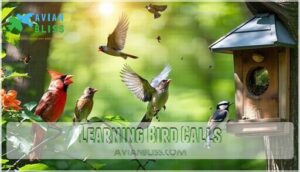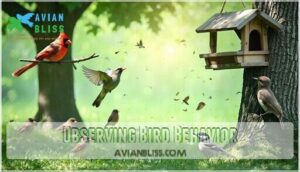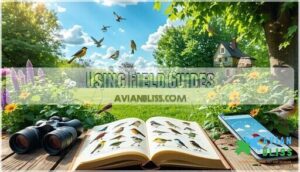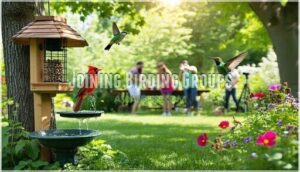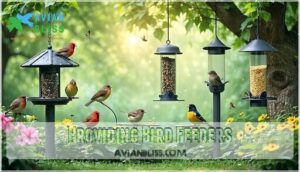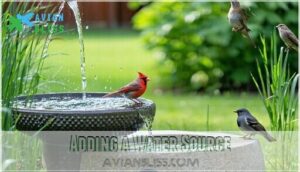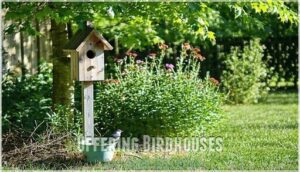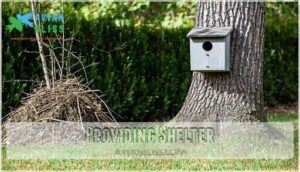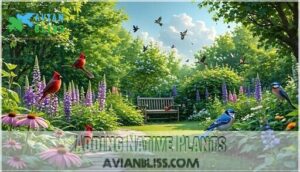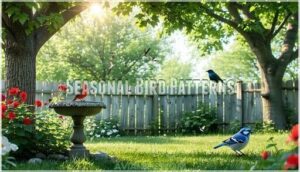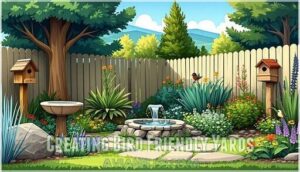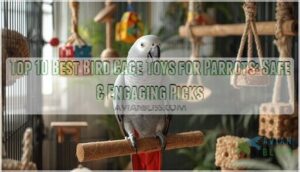This site is supported by our readers. We may earn a commission, at no cost to you, if you purchase through links.
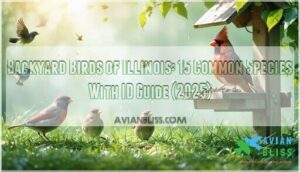
The bold red Northern Cardinal is impossible to miss, while American Robins are often spotted hopping on the grass, searching for worms.
Mourning Doves add a peaceful vibe with their soft cooing.
In winter, look for Dark-eyed Juncos with their crisp black-and-white plumage, like tiny tuxedoed visitors.
Song Sparrows, with their cheerful melodies, might surprise you from a shrub.
By adding bird feeders or a water source, you can turn your yard into a bird paradise.
There’s always more to discover about these fascinating companions!
Table Of Contents
- Key Takeaways
- Illinois Backyard Birds
- Bird Identification Tips
- Attracting Backyard Birds
- Seasonal Bird Patterns
- Creating Bird Friendly Yards
- Frequently Asked Questions (FAQs)
- How do I identify a bird in my backyard?
- What is the most common bird in Illinois?
- What are the small GREY and brown birds in Illinois?
- Which birds are found around your house?
- How do I know what birds are in my area?
- What is killing birds in my backyard?
- What are the little black and white birds in Illinois?
- What are the most common backyard birds in Illinois?
- When do backyard birds arrive in Illinois?
- How can I attract more birds to my yard in Illinois?
- Conclusion
Key Takeaways
- Keep your yard inviting by setting up bird feeders, birdbaths, and planting native plants to attract Illinois’ diverse bird species year-round.
- Learn to identify birds by observing their size, colors, markings, beak shapes, and unique behaviors like songs or flight patterns.
- Watch for seasonal patterns as migratory birds arrive in spring and fall, while species like Northern Cardinals and Dark-eyed Juncos brighten winter days.
- Avoid pesticides and maintain clean feeders and water sources to keep birds safe and create a healthy environment.
Illinois Backyard Birds
You’ll find 15 common bird species regularly visiting Illinois backyards throughout the year, from the bright red Northern Cardinal to the cheerful American Robin.
Discover 15 charming bird species gracing Illinois backyards, from vibrant Cardinals to cheerful Robins, bringing nature’s beauty to your doorstep.
These resident and seasonal visitors offer excellent opportunities for identification practice and can be attracted with proper feeders, water sources, and native plants.
Northern Cardinal Identification
Illinois’s beloved Northern Cardinal stands out as the state’s most recognizable backyard bird.
You’ll easily spot males with their brilliant red Cardinal Plumage and distinctive black face mask, while females showcase warm brown tones with subtle reddish highlights on wings and tail.
Their sturdy, cone-shaped Beak Shapes make cracking sunflower seeds effortless, explaining why they’re regular feeder visitors.
Listen for their distinctive Bird Songs – clear whistles that sound like "birdy-birdy-birdy" or "cheer-cheer-cheer."
Key identification features include:
- Males: Vibrant red Feather Patterns with black facial mask
- Females: Brown plumage with reddish wing and tail accents
- Both sexes: Orange-red beaks and prominent head crests
- Year-round residents: Active in Illinois backyards during all seasons
These Illinois bird species make backyard birding rewarding, offering consistent Northern Cardinal sightings that enhance your bird identification skills through regular observation.
Understanding their northern cardinal species profile is essential for appreciating their behavior and habitat needs.
American Robin Identification
When American Robins hop across your lawn with their distinctive gray backs and brick-red breasts, you’re witnessing one of Illinois’s most beloved bird species.
Their feeding habits include hunting earthworms and insects on open ground, while their nesting patterns favor trees and shrubs.
Robin habitat spans urban yards to woodlands throughout Illinois bird watch seasons.
| Feature | Description |
|---|---|
| Size | 8-11 inches long |
| Colors | Gray back, orange-red breast |
| Behavior | Ground foraging, territorial |
Their cheerful songs herald spring’s arrival across illinois bird species territories, making them a favorite for backyard birding with their stunning bird plumage that makes bird identification simple.
Dark-eyed Junco Identification
Snowbirds bring winter magic to your Illinois backyard with their distinctive slate-gray plumage and crisp white bellies.
Dark-eyed Juncos are reliable winter visitors that’ll brighten cold months with their cheerful ground-hopping antics.
Junco Plumage: Smooth slate-gray backs contrast beautifully with bright white undersides
Bird Size: About 6 inches long with compact, robin-like proportions
Feather Patterns: Clean color divisions create sharp contrast between dark and light areas
Beak Shape: Small, pink-colored cone perfect for cracking seeds
These Illinois bird species scratch through leaf litter searching for food.
Their Winter Habits include flocking together at feeders, making backyard birding rewarding.
Bird identification becomes easier once you recognize their distinctive two-toned appearance during Illinois bird sightings.
Mourning Dove Identification
Mourning Doves grace Illinois backyards with their gentle presence year-round. You’ll recognize these medium-sized birds by their soft gray-brown plumage and distinctive black spots along their wings. Their Bird Size measures about 12 inches with a slender build that’s unmistakable during flight.
Listen for their signature Dove Calls – a low, mournful "coo-OO-oo-oo" that echoes through neighborhoods. Watch their Wing Beats create a whistling sound during takeoff, while their pointed Tail Feathers display white outer edges in flight.
Feather Patterns show subtle iridescence on their necks, making Illinois bird identification easier. These common bird species illinois visitors prefer ground feeding, making backyard birding rewarding for enthusiasts tracking illinois bird sightings.
Song Sparrow Identification
The Song Sparrow is a charming addition to your backyard birdwatching in Illinois, known for its distinctive features and sweet melodies.
Spotting one is easy if you pay attention to these key traits:
- Feather Colors: Look for a streaky breast with a bold central spot and rusty brown stripes on its back.
- Beak Shapes: Notice its short, conical beak, perfect for cracking seeds.
- Song Patterns: Listen for its unique, complex tunes that vary by individual.
- Habitat Preferences: Often found in shrubs, gardens, or near water.
This adaptable bird is a favorite among Illinois birds, offering endless song variety!
Bird Identification Tips
You’ll identify Illinois backyard birds more accurately when you combine visual observation with behavioral cues and vocal patterns.
Start by noting key features like size, color patterns, bill shape, and feeding habits, then listen for distinctive calls to confirm your identification.
Learning Bird Calls
Once you’ve spotted Illinois birds in your yard, sound recognition becomes your secret weapon. Bird vocalizations reveal species identity even when you can’t see the singer.
Start with audio identification apps like Merlin Bird ID, which analyzes call patterns through sonogram technology. This tool transforms complex sounds into visual patterns you’ll understand quickly.
Focus on vocal learning by studying rhythm, pitch, and repetition. A Northern Cardinal’s "birdy-birdy-birdy" differs dramatically from a chickadee’s "chick-a-dee-dee-dee." Practice these patterns until they stick.
Understanding backyard bird habitats is essential for attracting various species, and you can learn more about native bird plants.
Illinois birds offer diverse learning opportunities year-round. Record calls with your phone, then compare them to field guide audio. Join local birdwatching groups where experienced birders share identification tricks.
Observing Bird Behavior
Several key behaviors reveal the secrets of your backyard birds. Watch how Illinois bird species move through your space—some hop while others walk with purpose. Notice their Social Interactions: Cardinals travel in pairs, while chickadees form mixed flocks during winter months.
Foraging Strategies reveal identity clues. Woodpeckers spiral up tree trunks, nuthatches work headfirst downward, and robins cock their heads listening for worms. Study Nesting Habits during breeding season—wrens stuff cavities with twigs, while orioles weave hanging baskets.
Bird behavior patterns help distinguish similar species:
- Flocking Patterns change seasonally as migrants join residents
- Bird Migration timing varies between early and late travelers
- Bird habitats influence daily routines and feeding schedules.
These bird watching tips transform casual observation into meaningful backyard birds identification.
Using Field Guides
Bird behavior observation sets the stage for your next identification tool.
Field guides transform your birding experience from guesswork into confident species recognition.
Choose guides featuring illinois bird species with clear photos and detailed range maps.
Digital bird identification apps offer audio clips alongside visual references, making birding tips instantly accessible.
Understanding bird identification techniques is essential for accurate species recognition.
| Guide Type | Best Feature |
|---|---|
| Print Field Guides | Detailed illustrations |
| Mobile Apps | Audio recordings |
| Regional Guides | Local species focus |
| Beginner Guides | Simple layouts |
| Photo Guides | Real bird images |
Quality bird field guides include observation skills sections and species lists for accurate illinois bird identification.
They provide a comprehensive approach to species recognition, making them an invaluable resource for any bird enthusiast.
Joining Birding Groups
Joining birding groups opens up a world of discovery and camaraderie. It’s not just about spotting birds—it’s about sharing the joy with others who love them as much as you do.
Birding communities in Illinois, like the Illinois Audubon Society, offer incredible opportunities to learn and grow.
- Local Meetings: Connect with nearby bird clubs for advice, workshops, and birdwatching outings.
- Group Tours: Explore new habitats with experienced birders who can help sharpen your skills.
- Membership Benefits: Gain access to events, newsletters, and conservation projects that deepen your connection to nature.
Whether it’s a Northern Cardinal or a Ruby-throated Hummingbird, birding groups make every sighting more meaningful.
Attracting Backyard Birds
You can attract a variety of birds to your yard by providing food, water, and shelter suited to their needs.
Adding native plants and birdhouses creates a welcoming habitat for both resident and migrating species.
Providing Bird Feeders
Transform your yard into a bird haven with the right bird feeders.
Opt for tube feeders for finches, platform designs for cardinals, or hopper styles for a mix of backyard birds.
Seed types like black oil sunflower, nyjer, and millet are magnets for Illinois bird species.
Place feeders in shaded, quiet spots to guarantee bird safety and reduce predator risks.
Add squirrel deterrents to protect your bird seed stash.
Regular cleaning is essential—dirty feeders can spread disease.
With thoughtful feeding strategies, you’ll attract vibrant visitors, especially during winter feeding when food sources are scarce for Illinois bird species.
By using the right feeders and seed types, you can attract top feeder bird species to your yard.
Adding a Water Source
Adding a water source transforms your yard into a bird-friendly backyard oasis. Birds need fresh water for drinking and grooming, and you can meet this need with simple setups.
- Birdbath Designs: Choose shallow birdbaths or creative water features like rain barrels or small fountains.
- Winter Prep: Install heated fountain systems or pond installations to keep water accessible during freezing months.
- Maintenance Matters: Clean birdbaths weekly to prevent algae, bacteria, and mosquitoes.
Proper placement is key—keep water features in shaded, safe areas.
With a little effort, your yard will hum with activity as birds flock to your inviting sanctuary. Considering various birdbath designs can help create an ideal environment for the birds.
Offering Birdhouses
A birdhouse isn’t just a decoration—it’s a lifeline for backyard birds in Illinois.
By offering bird nesting boxes suited to species like chickadees or wrens, you’re creating a safe haven. Focus on sturdy birdhouse designs with proper ventilation and predator guards.
Place them in shaded, quiet spots for ideal nest box placement. Clean them regularly to prevent disease, and scatter twigs or dried grass nearby for easy access to nesting materials.
Your yard becomes a cozy corner of Illinois bird habitats, perfect for roosting boxes and nesting platforms! To attract a variety of species, consider implementing sustainable birdhouse practices that support local ecosystems.
Providing Shelter
Your backyard can be a haven for Illinois bird habitats with the right shelters:
- Nest Boxes: Perfect for backyard birds like chickadees and wrens to raise their young.
- Brush Piles: A natural solution for roosting sites and hiding spots.
- Evergreens: These offer year-round cover and nesting opportunities.
- Dead Trees: Leave them standing as birdhouses for woodpeckers and cavity nesters.
Adding Native Plants
Swap plain grass for native flowers like purple coneflowers or wildflower seeds to create lush bird gardens.
Local shrubs such as elderberries provide snacks that backyard birds love.
Native grasses and bird-friendly plants also support Illinois bird habitats year-round.
Your yard becomes a vibrant ecosystem, blending bird conservation with natural beauty—perfect for feathered visitors and a thriving environment.
Seasonal Bird Patterns
You’ll notice different bird species in your backyard as the seasons change in Illinois. Understanding these seasonal patterns helps you identify which birds to expect and when.
Spring Birds in Illinois
Spring in Illinois brings colorful spectacles with illinois bird migration flourishing. Red-winged blackbirds charm with bold songs, while American robins feast on insects.
Listen for bird songs as indigo buntings flash vibrant feathers.
- Observe nesting habits as birds gather materials.
- Spot feather molting revealing bright spring plumage.
- Enjoy flocking behavior during Springfield birding or Chicago’s urban bird scenes.
Summer Birds in Illinois
Summer brings a spectacular show of colorful summer birds to Illinois habitats, buzzing with activity during the nesting season.
Watch backyard birds like American Robins, Indigo Buntings, and Song Sparrows feeding on insects to support feather care for their growing chicks.
- Top sightings: Red-winged Blackbirds flaunting fiery wings.
- Key habits: Nesting patterns and lively songs.
- Tips: Add feeders and fresh water to aid summer migration and support Illinois bird conservation efforts.
Fall Birds in Illinois
The magic of fall migration in Illinois turns your backyard into a pit stop for tired travelers.
From warblers to sparrows, fall birds hustle to stock up on food and prep their feathers for winter.
Keeping a close eye helps you notice dramatic changes in their plumage as they prepare to head south.
- Look for broad-winged hawks riding October thermals.
- Watch loons and ducks resting in water-laden Illinois habitats.
- Offer sunflower seeds and fresh water to attract migrating species.
Illinois bird species like grosbeaks might surprise you during this season.
These fleeting moments bring awe to bird watching, even in big cities like Chicago!
Winter Birds in Illinois
With winter’s chill blanketing Illinois, resilient birds stay active amid snowy landscapes. Backyard birds like Dark-eyed Juncos and year-round favorites like cardinals brighten cold weather days.
Dark-eyed Juncos and vibrant cardinals bring lively color and charm to Illinois backyards, brightening even the coldest winter days.
Illinois birding in winter reveals subtle plumage changes in species like goldfinches. Stock bird feeders with sunflower or Nyjer seeds to support their energy needs.
Let’s explore common winter habitats and behaviors:
| Bird Species | Preferred Habitat | Winter Food | Notable Behavior |
|---|---|---|---|
| Dark-eyed Junco | Snowy lawns | Mixed seeds | Hopping in small groups |
| Northern Cardinal | Brushy backyards | Sunflower seeds | Brightening quiet days |
| American Goldfinch | Open fields | Nyjer seeds | Subtle plumage changes |
| Snowy Owl | Open landscapes | Small mammals | Majestic daytime hunting |
Creating Bird Friendly Yards
You can transform your yard into a haven for birds by planting native trees and avoiding harmful pesticides.
Adding bird baths and bird-friendly plants creates essential habitats that support local species year-round.
Planting Native Trees and Shrubs
Create a bird-friendly backyard with native tree selection and shrubs that attract wildlife.
Native plants are stunning but also make your yard a lively habitat. Birds rely on these species for food, nesting, and rest.
Here’s a quick guide to garden design with local plant species:
- Dogwoods: Vibrant blossoms and berries perfect for birds.
- Oaks: Support countless insects, a key bird food source.
- Shrubs for Birds: Elderberry and spicebush offer cover and sustenance.
- Messy Corners: Let plants grow freely for essential migratory stopovers.
With thoughtful choices, your garden becomes a true wildlife conservation gem.
Using Bird-Friendly Plants
Using birdfriendly plants is a brilliant way to attract Illinois bird species to your yard.
Native plantings like dogwoods and serviceberries provide essential berries for robins and cardinals, while milkweed and pollinator plants like asters bring insects for species like wrens.
Add layers of greenery and shrubs to create a safe wildlife habitat.
Groundcovers support shelter, giving your bird garden a cozy vibe.
Sustainable landscaping with native plants turns your birdfriendly backyard into a buzzing wildlife garden.
Visit local shops for seeds suited to Illinois wildlife gardening needs.
By incorporating native plants, you can create a bird friendly habitat that supports local species throughout the year, making your yard a wildlife garden with a cozy vibe and essential berries.
Avoiding Pesticides
A chemical-free yard is key to creating a bird-friendly backyard in Illinois.
Pesticides harm birds and disrupt the balance of your wildlife gardening efforts. Organic gardening offers eco-friendly, sustainable landscaping solutions that keep birds safe while enhancing your garden.
Here are three simple ideas for effective, natural pest control:
- Plant Marigolds: Their bright blooms repel pests while adding beauty to your yard.
- Encourage Ladybugs: These “tiny warriors” devour aphids and other troublesome insects.
- Use Neem Oil Sparingly: This natural option works well in emergencies without harming your feathered friends.
By skipping chemicals, you’ll help backyard birds thrive while fostering a healthier, more balanced ecosystem right in your own yard.
Creating a Bird Bath
Bird baths are a rejuvenating way to attract backyard birds in Illinois while supporting bird conservation.
Opt for sturdy Bird Bath Designs, using materials like stone or ceramic.
Keep water shallow—1 to 2 inches—for easy Bird Hydration.
Place baths near shrubs for a safe, bird friendly backyard while offering great bird-watching spots.
Weekly Birdbath Maintenance prevents algae and mosquitoes.
In winter, a Fountain Installation or heater guarantees water stays unfrozen.
A clean, accessible Water Feature transforms your yard into an oasis for Illinois birds year-round!
Considering bird bath designs is vital for creating an inviting space.
Frequently Asked Questions (FAQs)
How do I identify a bird in my backyard?
Isn’t it fun when a brightly feathered visitor catches your eye?
To identify a bird, note its size, colors, markings, beak shape, and behavior.
Observing its songs or calls helps too!
What is the most common bird in Illinois?
The Northern Cardinal is Illinois’ most common bird.
You’ll spot males flaunting brilliant red feathers, while females sport a subtler orangish-brown.
Their melodic whistles brighten mornings, making them a favorite guest at backyard feeders.
What are the small GREY and brown birds in Illinois?
Over 60% of birds in Illinois fit the small, gray, or brown category.
Keep an eye out for subtle beauties like Tufted Titmice, House Wrens, and Carolina Wrens—they’re tiny, fast, and fascinating to watch!
Which birds are found around your house?
You’ll often see cardinals, chickadees, and sparrows flitting through bushes or perching on feeders.
Woodpeckers drum on trees, while goldfinches brighten yards in summer.
Sometimes, a mischievous blue jay might steal the scene!
How do I know what birds are in my area?
Grab binoculars, a bird guide, or smartphone app.
Check local parks or your backyard at dawn or dusk for active species.
Listen for unique calls and observe wing patterns or feeding habits to identify them.
What is killing birds in my backyard?
Predators like cats, poison, or window collisions might be to blame.
House sparrows can also spread diseases.
Keep feeders clean, avoid chemicals, and cover windows with decals or screens to protect your backyard birds.
What are the little black and white birds in Illinois?
When life throws you little puzzles, those black-and-white birds might be Chickadees or Downy Woodpeckers.
Chickadees sport black caps and bibs, while Downy Woodpeckers flash spotted wings—perky personalities bound to brighten your day, with their black-and-white coloration being a notable feature.
What are the most common backyard birds in Illinois?
Northern Cardinals, Blue Jays, American Goldfinches, and Chickadees are frequent backyard visitors in Illinois.
You’ll also spot Downy Woodpeckers, House Sparrows, and Red-winged Blackbirds adding vibrant energy and color to your yard, with American Goldfinches being a notable presence.
When do backyard birds arrive in Illinois?
Spring’s arrival is like nature’s curtain call, welcoming migratory birds back to Illinois.
From warblers in early April to ruby-throated hummingbirds mid-May, each species has its perfect timing, filling backyards with vibrant colors and songs.
How can I attract more birds to my yard in Illinois?
Set out feeders with seeds, suet, or fruit, and add native plants for food and shelter.
A birdbath or fountain helps, too.
Skip pesticides, and let nature weave its magic in your yard.
Conclusion
Surprisingly, your own backyard can host an array of vibrant bird species, each bringing unique beauty and behaviors.
Whether it’s the fiery Northern Cardinal or a wintery Dark-eyed Junco, the backyard birds of Illinois offer endless opportunities for observation and learning.
By providing feeders, water, and native plants, you’ll create a haven for these fascinating creatures.
Watch for seasonal patterns and listen for their songs—it’s a rewarding way to connect with nature every day.
- https://birdfeederhub.com/backyard-birds-in-illinois/
- https://learnbirdwatching.com/most-common-birds-in-illinois/
- https://whatbirdsareinmybackyard.com/illinois-birds/
- https://news.illinois.edu/illinois-study-backyards-urban-parks-support-bird-diversity-in-unique-ways/
- https://ace-eco.org/vol18/iss1/art24/

